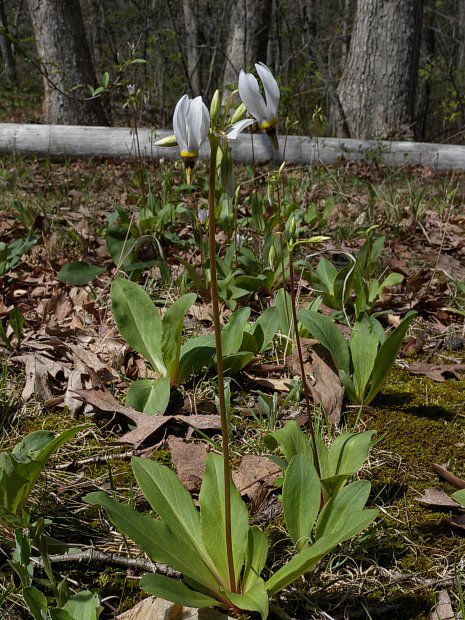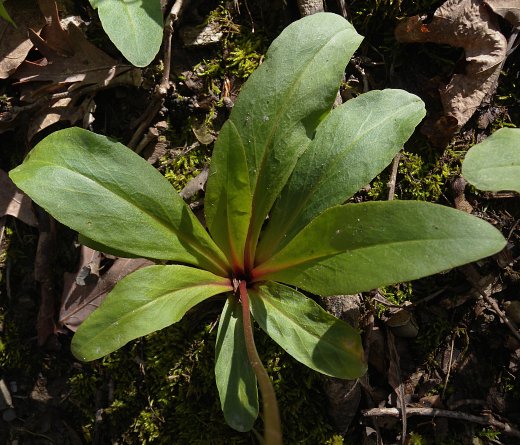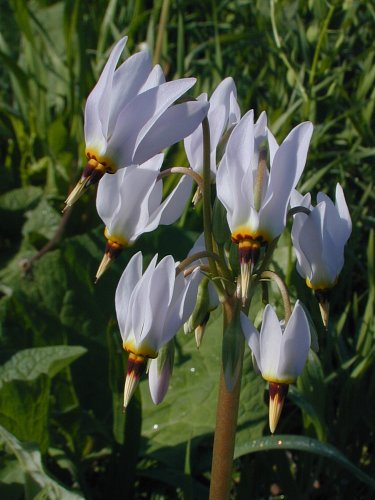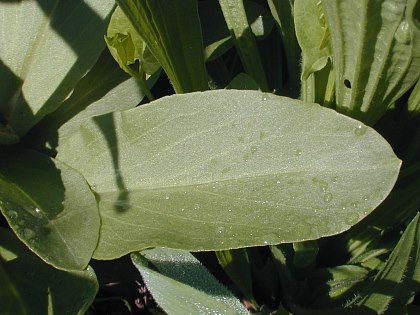Description: This perennial plant consists of a basal rosette of leaves, from which emerges one or more stalks of flowers. The leaves are up to 6" long and 2½" across, and broadly oblong or oblanceolate-elliptic. They are greyish green or green with a prominent central vein and smooth margins. There are finer lateral veins that are pinnately arranged. The foliage and other parts of this plant are hairless. A green or red flowering stalk emerges from the rosette that is about 1–1½' tall, from which an umbel of about 6-40 flowers dangle downward.

Each flower has 5 petals that are reflexed upward, converging at the base of the flower, which consists of a yellowish reproductive cone with white and brown accents. The petals are white, light pink, or rosy pink. There is no floral scent. In overall appearance, the inflorescence looks like a collection of pretty shooting stars, hence the common name for this plant. The blooming period occurs during late spring and lasts about a month. The entire plant dies down when summer arrives, although the dried up stalks persist somewhat longer. The small dark seeds are contained in seed capsules that are held erect (unlike the flowers). They are somewhat cylindrical, but taper at the ends. Gusts of wind shake the stalks holding the seed capsules; this can carry the seeds several feet away. The root system is fibrous. Over time, offsets can slowly develop.

Cultivation: The preference is full or partial sun, and moist to slightly dry soil. Shooting Star can thrive on dry sunny slopes if there is sufficient rainfall during the spring because it dies down before summer droughts arrive. The soil can consist of loam with lots of organic material, or contain some rocky material. There is a preference for slopes, which reduces competition from taller plants. The foliage of mature plants dies down before disease can affect it. Shooting Star can be difficult to start from seed because of damping off, and it is slow to develop because of the short period of active growth. Transplants can also be temperamental, particularly if they are too small, or dug into the ground after the cool rainy weather of spring.

Range &
Habitat:
The native Shooting Star occurs in the majority of counties in Illinois
(see Distribution
Map). This plant is occasional to locally common in high
quality habitats, otherwise it is rare or absent. Habitats include
moist to slightly dry black soil prairies, hill prairies, openings in
rocky upland forests, limestone glades, bluffs along major rivers,
fens, and abandoned fields. An occasional wildfire during the late
summer or fall is beneficial because it reduces the dead vegetation
that can smother this plant during the spring.
Faunal Associations:
Queen bumblebees are the most typical visitors of the oddly shaped
flowers. They obtain pollen from the flowers by the rapid vibration of
their thoracic muscles, which is sometimes called 'buzz pollination.'
Other bees visiting the flowers are Anthophorine bees, long-horned
bees (Melissodes spp.), and green metallic bees (Augochlorella,
Augochloropsis). All of these insects collect pollen, as
the flowers offer no nectar reward. Mammalian herbivores may feed on
the foliage
during the spring, but little information is available about this.

Photographic
Location:
The photographs were taken at a
wildflower garden near the Red Bison Railroad Prairie in Champaign,
Illinois, and an upland woodland opening at Lakeview Park in Coles
County, Illinois.
Comments:
This is one of the most beautiful spring wildflowers in the prairie. A
colony of these plants in bloom is a sight not to be missed. The
flowers of Shooting Star resemble in form those of Horse Nettle (Solanum
carolinense) and other members of the Nightshade family. This
is an example of convergent evolution between plants of different
families because of similarities in the method of pollination. Early
pioneers called this plant 'Prairie Pointers.'